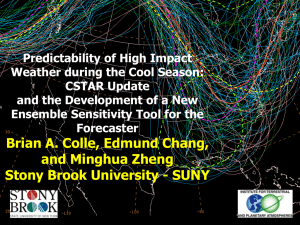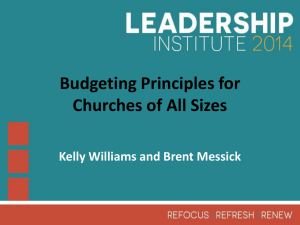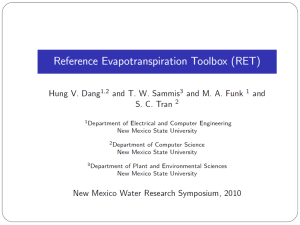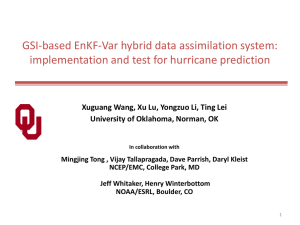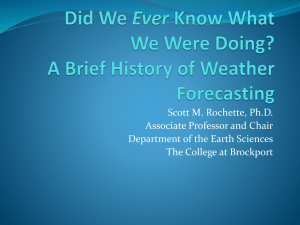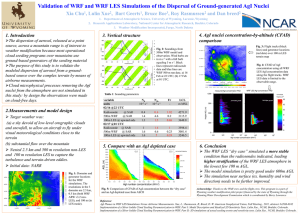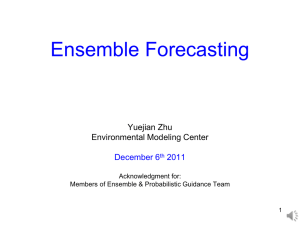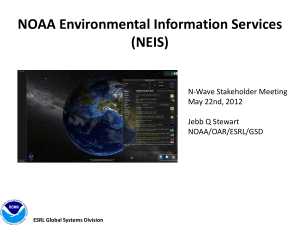10.3
advertisement
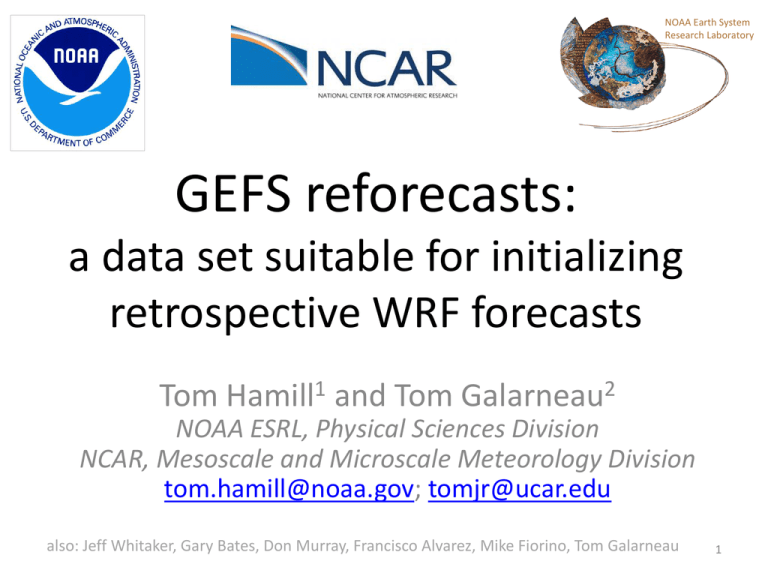
NOAA Earth System Research Laboratory GEFS reforecasts: a data set suitable for initializing retrospective WRF forecasts Tom Hamill1 and Tom Galarneau2 NOAA ESRL, Physical Sciences Division NCAR, Mesoscale and Microscale Meteorology Division tom.hamill@noaa.gov; tomjr@ucar.edu also: Jeff Whitaker, Gary Bates, Don Murray, Francisco Alvarez, Mike Fiorino, Tom Galarneau 1 Challenge: realistic LBC’s for WRF • Use of reanalysis data rather than global forecast data for LBC’s can result in: – Inappropriately small errors in forecast LBC’s, hence results that are unrealistic of real-time applications. – Large time interpolation at lateral boundary due to 6hourly updates common with reanalyses. • Possible remedies – Nested domains, with very large outer domain. – Use a global model forecast data for LBCs…but from where? 2 Forecast, 0900 UTC Forecast, 1200 UTC Example: interpolation errors in Aladin simulation of 1999 Lothar storm temporal interpolation creates two lows from one. Ref: Tudor & Termonia, MWR, July 2010 Forecast, 1030 UTC (zoomed in) Temporal interpolation, 1030 UTC(zoomed in) 3 Reforecasts (hindcasts) Numerical simulations of the past weather using the same forecast model and assimilation system that is used operationally. 4 2nd-generation GEFS reforecast: details • Past forecasts using NCEP GEFS operational configuration as of February 2012. This version still operational, though data assimilation method was improved in May 2012. • Reforecasts produced every day, for 1984120100 to current. • Each 00Z, 11-member forecast, 1 control + 10 perturbed. • CFSR (NCEP’s Climate Forecast System Reanalysis) initial conditions (3D-Var) + ETR perturbations (cycled with 10 perturbed members). After ~ 22 May 2012, initial conditions from hybrid EnKF/3D-Var. • Spatial resolution: T254L42 to day 8, T190L42 from days 7.5 to day 16. • Temporal resolution: 3-hourly to +72 h, 6 hourly thereafter. • Fast data archive at ESRL of 99 variables, 28 of which stored at original ~1/2-degree resolution during week 1. All stored at 1 degree. Also: mean and spread to be stored. • Full model archive at DOE/Lawrence Berkeley Lab, where data set was created under DOE grant. 5 Status of the reforecast v2 archive. • 00Z reforecast data and (since mid-2012) 00Z GEFS real-time forecasts are publicly available from our archive. • Download web sites are open to you now: – NOAA/ESRL site: fast access, limited data (99 fields). Also there, README & info on how to ftp. • http://www.esrl.noaa.gov/psd/forecasts/reforecast2/ – US Department of Energy: slow access, but full model states. • http://portal.nersc.gov/project/refcst/v2/ 6 Skill of the raw reforecasts 7 500 hPa Z anomaly correlation (from deterministic control) Lines w/o filled colors for second–generation reforecast (2012, T254) Lines with filled colors for first-generation reforecast (1998, T62). Perhaps a 1.5-2.5 day improvement relative to 1st-generation reforecasts. 8 Tropical cyclone track errors Less statistical consistency of errors over the period of the reforecasts, as opposed to 500 hPa anomaly correlation, which emphasizes mid-latitude variability. 9 At this URL, a tape archive of the full forecast model states, suitable for WRF initialization and LBC’s 10 Some notes running WRF using data from this archive ( from http://www.esrl.noaa.gov/psd/forecasts/reforecast2/README.GEFS_Reforecast2.pdf ) • The proper Vtable file must be created prior to preprocessing the GEFS reforecast data. To do this, copy Vtable.GFS to your working directory for preprocessing the GRIB2 GEFS reforecast data. Rename the Vtable.GFS file as Vtable.reforecast, and modify the file as follows. First, add a line for specific humidity on pressure levels and at 2 m. The specifications for specific humidity should be as follows: metgrid Description: Specific Humidity metgrid units: kg kg1 metgrid Name: SPECHUMD GRIB2 Discp=0, Catgy=1, Param=0, Level=100 GRIB1 Param=52, Level Type=100, From Level1=* metgrid Description: Specific Humidity at 2 m metgrid units: kg kg1 metgrid Name: SPECHUMD GRIB2 Discp=0, Catgy=1, Param=0, Level=103 GRIB1 Param=52, Level Type=105, From Level1=2 • Second, remove the GRIB2 parameter number for relative humidity on pressure levels and at 2m. Note that ungrib.exe and metgrid.exe will calculate relative humidity for you if you have specific humidity. Finally, change the GRIB2 parameter number for PMSL from 1 to 0. No other known modifications to the Vtable are needed. Now that the Vtable.reforecast file is properly created, follow the instructions for running WRFARW on the WRF Users’ Page [http://www.mmm.ucar.edu/wrf/users/]. • The files downloaded from DOE will have the fields for the different forecast lead times merged into one grib file. It will be your responsibility to break up that into separate grib files for each lead time. 11 Demo: WRF ARW Regional Reforecast of Hurricane Rita (2005) • An example of generating a WRF high-resolution regional reforecast ensemble using GEFS initial and LBCs • Will show in this case that regional reforecast WRF ensemble provided value-added guidance to global ensemble forecast. Details of reforecast with WRF ARW v3.4 using GEFS for initial, boundary conditions • Nested simulation 36-, 12- and 4-km with 36 vertical levels – • • • • • • • • • • • • • • 12- and 4-km moving nests Time steps: 180, 60, and 20 s Initial and boundary conditions from GFS reforecast ensemble members Tiedtke cumulus scheme on 36 and 12 km; explicit on 4 km outer WRF domain YSU PBL scheme HYCOM ocean analysis WSM6 microphysics Noah land surface 2D Smagorinsky turbulence scheme Goddard shortwave radiation RRTM longwave radiation Second order diffusion Positive definite scalar advection Donelan wind-dependent drag formulation Garratt wind-dependent enthalpy surface fluxes 13 WRF-ARW reforecast ensemble results • Global reforecast ensemble is consistent with NHC forecast; indicating potential impact on Houston • Significant left-of-track error and intensity was underestimated • Rita vortex intensified in ARW regional reforecast despite terrible initial vortex • Similar left-of-track error in ARW; suggests large-scale control on TC motion Maximum reflectivity (dBZ) 50-h ARW Forecast Verifying 02Z/24 Sep ‘05 Control SLP (contours every 4 hPa) 2-m Temperature (shaded in °C) 10-m wind (barbs in knots) 50-h ARW Forecast Verifying 02Z/24 Sep ‘05 Control 10-m wind speed (m/s) 10-m wind (barbs in knots) 50-h ARW Forecast Verifying 02Z/24 Sep ‘05 Control Ensemble Analysis: 500 hPa Z 24-h ARW Forecast (36-km domain) verifying 0000 UTC 23 Sep 2005 Philippe right members left members Rita 500 hPa Z difference (right minus left; shaded in m), right mean (magenta every 60 m), and left mean (black every 60 m) Ensemble Analysis: 500 hPa Z 48-h ARW Forecast (36-km domain) verifying 0000 UTC 24 Sep 2005 Philippe right members left members Rita 500 hPa Z difference (right minus left; shaded in m), right mean (magenta every 60 m), and left mean (black every 60 m) Ensemble Analysis: 500 hPa Z 48-h ARW Forecast (36-km domain) verifying 0000 UTC 24 Sep 2005 Mid-latitude flow pattern more progressive/amplified for right-track members Philippe right members left members Rita 500 hPa Z difference (right minus left; shaded in m), right mean (magenta every 60 m), and left mean (black every 60 m) Conclusions • This new GEFS global reforecast data set may facilitate running retrospective WRF forecasts in a more appropriate manner, with LBC’s from a forecast model, thus more realistic of a real-time configuration. • Demonstrated successfully for hurricane Rita. • GEFS information readily available, easy to use. • An article on the data set and its applications is in press at BAMS, http://journals.ametsoc.org/doi/pdf/10.1175/BAMS-D-12-00014.1 21 TC Rita (2005) GFS reforecast ensemble 72-h forecast initialized at 00Z 22 Sept 00Z/22 00Z position P01 P02 P03 P04 P05 P06 P07 P08 P09 P10 P11 OBS 22 TC Rita (2005) ARW ensemble with GFS reforecast ensemble as boundary and initial conditions 00Z/22 72-h forecast initialized at 00Z 22 Sept 00Z position P01 P02 P03 P04 P05 P06 P07 P08 P09 P10 P11 OBS 23 Data that is readily available on spinning disk from ESRL This is rather coarse vertical resolution for initialization of a regional model, though. 24 Data that is readily available on spinning disk from ESRL (continued) [Y] indicates that this variable is available at the native ~0.5-degree resolution as well as the 1-degree resolution.25 http://esrl.noaa.gov/psd/forecasts/reforecast2/download.html Produces netCDF files. Also: direct ftp access to allow you to download the raw grib files. 26
